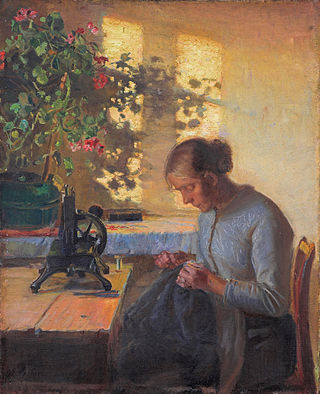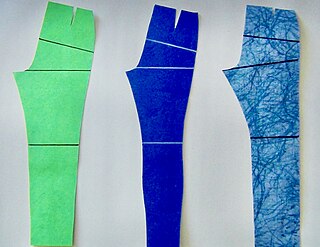
A sewing machine is a machine used to sew fabric and materials together with thread. Sewing machines were invented during the first Industrial Revolution to decrease the amount of manual sewing work performed in clothing companies. Since the invention of the first sewing machine, generally considered to have been the work of Englishman Thomas Saint in 1790, the sewing machine has greatly improved the efficiency and productivity of the clothing industry.

Sewing is the craft of fastening or attaching objects using stitches made with a sewing needle and thread. Sewing is one of the oldest of the textile arts, arising in the Paleolithic era. Before the invention of spinning yarn or weaving fabric, archaeologists believe Stone Age people across Europe and Asia sewed fur and leather clothing using bone, antler or ivory sewing-needles and "thread" made of various animal body parts including sinew, catgut, and veins.

A hem in sewing is a garment finishing method, where the edge of a piece of cloth is folded and sewn to prevent unravelling of the fabric and to adjust the length of the piece in garments, such as at the end of the sleeve or the bottom of the garment.

Darning is a sewing technique for repairing holes or worn areas in fabric or knitting using needle and thread alone. It is often done by hand, but using a sewing machine is also possible. Hand darning employs the darning stitch, a simple running stitch in which the thread is "woven" in rows along the grain of the fabric, with the stitcher reversing direction at the end of each row, and then filling in the framework thus created, as if weaving. Darning is a traditional method for repairing fabric damage or holes that do not run along a seam, and where patching is impractical or would create discomfort for the wearer, such as on the heel of a sock.

In sewing and fashion design, a pattern is the template from which the parts of a garment are traced onto woven or knitted fabrics before being cut out and assembled. Patterns are usually made of paper, and are sometimes made of sturdier materials like paperboard or cardboard if they need to be more robust to withstand repeated use. The process of making or cutting patterns is sometimes compounded to the one-word Patternmaking, but it can also be written pattern(-)making or pattern cutting.

For woven textiles, grain refers to the orientation of the weft and warp threads. The three named grains are straight grain, cross grain, and the bias grain. In sewing, a pattern piece can be cut from fabric in any orientation, and the chosen grain or orientation will affect the way the fabric hangs and stretches and thus the fit of a garment. Generally speaking a piece is said to be cut on a particular grain when the longest part of the pattern or the main seams of the finished piece are aligned with that grain. Non-woven materials such as felt, interfacing or leather do not have a grain.

In sewing, to tack or baste is to sew quick, temporary stitches that will later be removed. Tacking is used for a variety of reasons, such as holding a seam in place until it is sewn properly, or transferring pattern markings onto the garment. Tacking is typically sewn using a specialised tacking thread, which may snap easily in order for it to be easily removed from the garment when necessary.

Mary Brooks Picken was an American author of 96 books on needlework, sewing, and textile arts. Her Fashion Dictionary was published by Funk and Wagnalls in 1957.

A selvage or selvedge is a "self-finished" edge of a piece of fabric which keeps it from unraveling and fraying. The term "self-finished" means that the edge does not require additional finishing work, such as hem or bias tape, to prevent fraying.
The manufacture of textiles is one of the oldest of human technologies. To make textiles, the first requirement is a source of fiber from which a yarn can be made, primarily by spinning. The yarn is processed by knitting or weaving, which turns yarn into cloth. The machine used for weaving is the loom. For decoration, the process of colouring yarn or the finished material is dyeing. For more information of the various steps, see textile manufacturing.

Helen Augusta Blanchard was an American inventor who received 28 patents between 1873 and 1915. She was known for her numerous inventions dealing with sewing machines and sewing technology.

Gathering turns the edge of a piece of fabric into a bunch of small folds that are held together by a thread close to the edge. Gathering makes the fabric shorter where it is stitched. The whole of the fabric flares out into irregular, rolling folds beyond the gathered stitching. Gathering can be done by hand, with a machine, automatically, with elastic, or through channels.

Charmeuse is a lightweight fabric woven with a satin weave. These float threads give the front of the fabric a smooth, shiny finish, whereas the back has a dull finish. Charmeuse differs from plain satin in that charmeuse has a different ratio of float (face) threads, and is of a lighter weight. Charmeuse may be made of silk, polyester, or rayon. Charmeuse woven from blended fibers has also become more common. It is used in women's clothing such as lingerie, evening gowns, and blouses, especially garments with a bias cut. It is occasionally used in menswear.

The straight or running stitch is the basic stitch in hand-sewing and embroidery, on which all other forms of sewing are based. The stitch is worked by passing the needle in and out of the fabric at a regular distance. All other stitches are created by varying the straight stitch in length, spacing, and direction.

In sewing, a seam is the join where two or more layers of fabric, leather, or other materials are held together with stitches. Prior to the invention of the sewing machine, all sewing was done by hand. Seams in modern mass-produced household textiles, sporting goods, and ready-to-wear clothing are sewn by computerized machines, while home shoemaking, dressmaking, quilting, crafts, haute couture and tailoring may use a combination of hand and machine sewing.

In sewing and tailoring, facing is a small piece of fabric, separate or a part of the garment fabric itself, used to finish the fabric edges. This is distinguished from hemming which simply folds the edge over; facing is a more substantial layer of additional fabric added to the edges of the garment. The facing adds addition support, strength and prevents stretching. Facing makes a garment look professionally finished with the seams well hidden inside the folds of the facing. Facing is mostly used to finish the edges in necklines, armholes, hems and openings. They are also used widely in all other sewing like quilts and home decor items like curtain hems.

A blind stitch in sewing is a method of joining two pieces of fabric so that the stitch thread is invisible during the normal use of the finished product. Blind stitching uses a folded edge of the fabric to hide the stitches; therefore, this type of stitch can be used to create a blind hem or to join two folded edges together.

A coverstitch is formed by two or more needles which add straight stitches to one side of the fabric and a looper thread on the opposite side of the fabric that zig-zags between the straight stitches. A coverstitch results in parallel lines of straight stitches on one side of the fabric and an overcast stitch on the reverse side. It is widely used in garment construction, particularly for attaching trims and flat seaming where the raw edges can be finished in the same operation as forming the seam.

Pin weaving is a form of small-scale weaving traditionally done on a frame made of pins; the warp and weft are wrapped around the pins. Pin-woven textiles have a selvage edge all the way around.





















